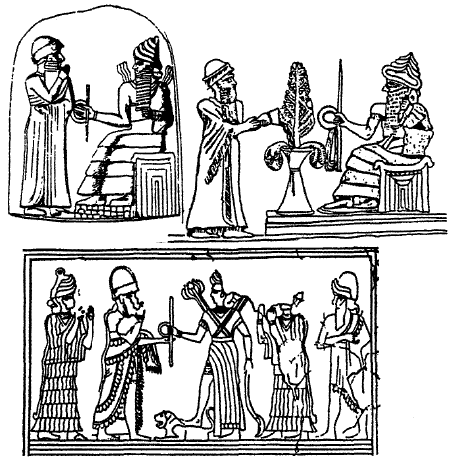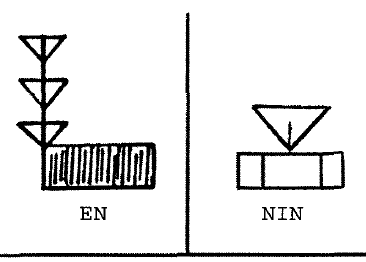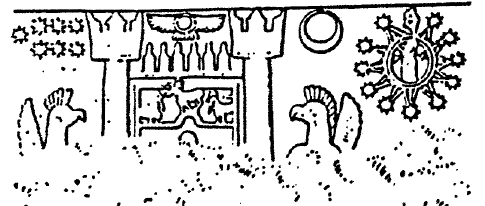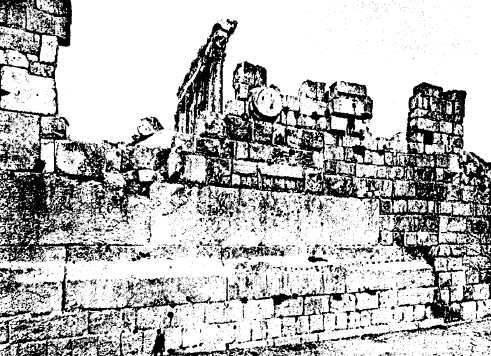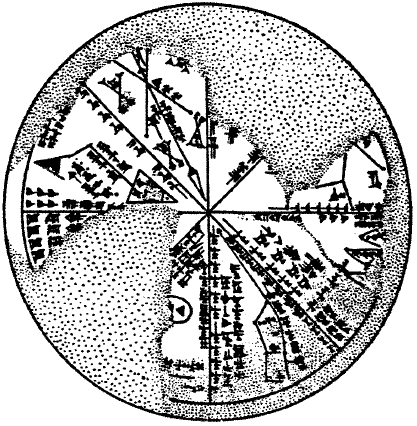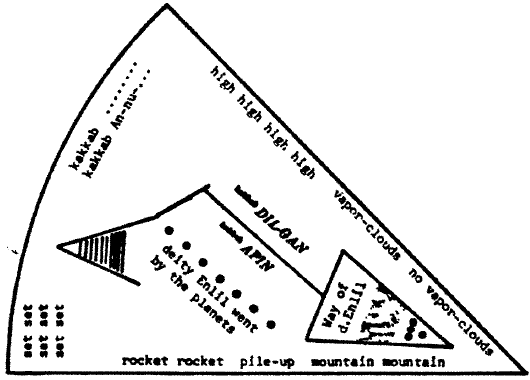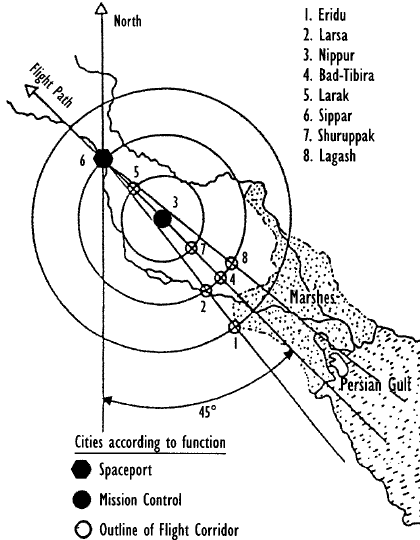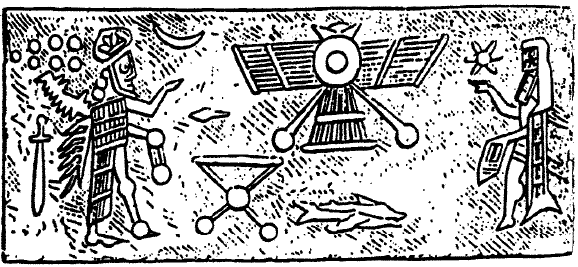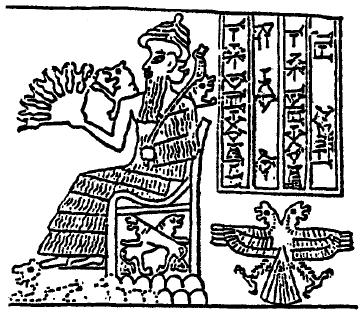|
Now it was time to translate his celestial supremacy to supremacy among the Anunnaki - the heavenly gods who came to Earth.
Then, as the tale continues on Tablet V, other deities - including Marduk’s real mother, Damkina (renamed Ninki after Ea was titled ‘Enki’ = ‘Lord of Earth’) - take the stage; and the listener (or reader) finds himself witnessing Marduk’s coronation as ‘king’ not only by the Anunnaki gods, but also by another group of deities called Igi.gi (‘Those Who Observe and See’).
Compliance to that request/demand followed:
The text does not state where the Assembly is gathered.
The narrative suggests that the coronation of Marduk is taking place on Nibiru, and it is followed by an assembly of the gods assigned to Earth. Reminding the gathered gods of his royal lineage (some ancestors who preceded Ea and Anu are invoked), Marduk, as the newly elected Chief, loses no time in outlining his divine program:
"In the Below" - on Earth - Marduk says, he has created Firm Ground suitable for a New Home:
As the gathered gods rejoiced at hearing Marduk’s project to establish Babylon, he went on to assign them their duties:
The gods assigned to ‘Mission Earth’ are thus divided right off into two groups:
By the end of Tablet VI Bab-ili (Babylon), the "Gateway of the gods," with its "Tower that reaches heaven," are ready; the Celestial Marduk is now also Marduk on Earth; and the reciting of Enuma elish proceeds to Tablet VII, which is a laudatory list of Fifty Names, fifty epithets of empowerment.
Life has yet to emerge and evolve on Earth; Enki and his first crew of fifty Anunnaki are yet to splash down; cities of the gods need to be established; Man has yet to appear; and the Deluge still has to sweep over - for only in its aftermath does the episode of the Tower of Babylon take place.
Whether the omissions are deliberate or not, the fact remains that all the interim developments still need to take place - not only according to the Bible, but also according to varied cuneiform texts.
The divine-royal abode he plans to establish on Earth is to serve as a counterpart to the divine-royal abode of the god Anu, the E.sharra, on Nibiru.
While Enuma elish provides no such answers, we are not entirely at a loss to know them.
Varied ancient texts fill-in data and details, name names and describe events. We have already mentioned some of those texts; we will bring to light many others - some even in languages other than Sumerian or Akkadian. Together they provide the dots that can be connected to form a coherent and continuous tale.
Paramount in that context is what they tell us about ourselves - how Man and Mankind came to be on this planet Earth.
One can assume that it was Anu’s form of Kingship that was "brought down from heaven" by the Anunnaki, and it was from his court that the traditional insignia of kingship emanated:
These symbols appear in divine investiture depictions at all times, in which the god or the goddess grants these objects to the new king (Fig. 56).
We thus learn that in addition to his official consort (his spouse, Antu) Anu had six concubines; his offspring were eighty in number (only fourteen of whom bore the divine titles En for males or Nin for females [Fig. 57]).
His court
aides included a Chief Chamberlain, three Commanders in charge of
the Rocketships, two Commanders of the Weapons, a ‘Minister of the
Purse’ (= Treasurer), two Chief
Figure 56
Other celestial symbols - a twelve-member solar system, a crescent (for the Moon) and seven dots (for Earth) complete the presentation.
Figure 58
Anu sat on his throne, flanked by his son Enlil seated on the right and his son Ea seated on his left. Texts that recorded Assembly proceedings indicate that virtually anyone present could speak up; some of the deliberations were heated debates.
But in the end Anu’s word was final - "his decision was binding." Among his epithets was "Divine 60" - granting Anu, under the sexagesimal (‘Base 60’) numbering system, the highest rank.
The most comprehensive, known to scholars by its opening line as the series An:god-Anu and deemed the Great God List, occupies seven tablets and contains more than 2,100 names or epithets of gods and goddesses - a mind-boggling number for sure, but considerably misleading if one realizes that sometimes a score or more listings were really epithets for the same deity (the younger son of Enlil, for example, who was called Ishkur in Sumerian, Adad in Akkadian, and Teshub by the Hittites, had another 38 epithet-names).
The Great God List also included the deities’ spouses and offspring, chief ‘viziers’ and other personal attendants.
Among other shorter or partial god lists thus far discovered was also one known as the series An:Anu Sha Ameli; despite its Akkadian title, it is an earlier basic listing of the Sumerian pantheon (listing only 157 names and epithets).
This list of Anu’s predecessors ends with the postscript "21 en ama aa" - ‘twenty-one lordly mothers and fathers’ (arranged as ten couples plus an unespoused male one). The Great God List then names the children and functionaries of Anu’s Group, skipping his two principal sons and daughter (Ea/Enki, Enlil and Ninmah), who are listed separately with their own family groups and aides.
Serving, then, as the royal Cup Bearer - a task calling for utmost loyalty - Anu betrays the king’s trust and seizes the throne in a bloody coup d’etat.
Why?
Though he bears the epithet-title "First among the gods," the text fails to reveal the relationship between Anu and the reigning king; but the narrator’s appeal to the Olden Gods, "The fathers and the mothers" of the gods, indicates a conflict or struggle over the throne whose roots go back several generations - a conflict caused by past events, genealogical relationships, or dynastic rivalries.
With succession rules that tried to untangle conflicting claims between a firstborn and a legal heir, between a son by a spouse and another by a concubine, and a rule granting primacy to a son by a half-sister, Anu evidently had a claim on the throne that (in his view) trumped that of Alalu.
In the Great God List (the extant version was probably compiled in Babylon) the Enki Group follows that of Anu’s; the Enlilites come next, followed by Ninharsag’s group.
But in other lists - including the shorter Sumerian one - it is the Enlil Group that follows Anu’s. These varied positionings reflect a tug-of-war that calls for a closer look.
These are divine predecessor couples of Enki that are not found in the Anu group. It is only when the list comes to the tenth couple, named Enshar and Kishar, that an apparent match with Anshar and Kishar in Anu’s list occurs.
Since Anu was Enki’s father, the separate or non-Anu ancestor couples had to represent the line of Enki’s mother, who had to be someone other than Antu - in other words, a concubine. That, it became clear as events unfolded, was a serious hierarchial defect.
Firstborn indeed he was; engendered by "fecund seed" he was - but only from his father’s side.
When it came to be seated beside the enthroned Anu, it was Enlil who sat on the right. In the numerical ranking of the elite Twelve Great Gods, Enlil was second to Anu with the rank of 50; Enki followed with the lesser rank of 40.
Though Enki was the firstborn, he was not the Crown Prince; that title with the right of succession was granted to the younger Enlil because his mother was Antu - and Antu was not just Anu’s official spouse, she was also a half-sister of Anu, providing Enlil with a double dose of the "fecund" genetic seeds.
The name of the deposed king (Alalu in Hittite) is clearly different from the many ‘En- ones, but is virtually identical to the oddly named Alala in Anu’s list, suggesting affiliation to a different clan and access to the throne through intermarriage.
The data in the God Lists suggests that his overthrow was a continuation of unresolved strife between the Niburian clans. It was neither the first nor the last violent ‘regime change’: Some texts suggest that Alalu himself was a usurper, and that later on attempts were made to overthrow Anu...
Come to think of it, it means that five military men made up almost half the ministerial cabinet of eleven (we exclude the seven scribes). This is tantamount to a military government. There is an obvious stress on weaponry: Two of the five generals deal just with weaponry. When it comes to the palace proper, it was protected by two awesome weapons systems, overseen by two royal princes.
Whether or not the Sbarur and Shargaz that protected Anu’s palace were such weapons, it is evident that nuclear weapons were part of the Nibiruan military arsenal. Were they ever used on Nibiru? Why not, if they were used on a distant planet called Earth, on which at their peak just 900 Nibiruans (600 Anunnaki, 300 Igigi) were stationed? So much more was at stake on Nibiru itself!
Seasons have even been detected on ‘Exoplanets’ orbiting other distant star-suns - planets whose mere notion of their possible existence was the domain of science-fiction until a few years ago.
It is noteworthy that in The 12th Planet (1976) we had already provided evidence that a habitable Mars served the Anunnaki as a way station for the interplanetary spacecraft from and to Nibiru; it was there that the Igigi were stationed, their task to operate smaller shuttlecraft between Earth and Mars.
The vast stone
platform still exists; so do the remains of the launch tower - built
of immense stone blocks that range from 600 to 900 tons each.
It is only
logical to assume that planet Nibiru underwent similar natural
events.
Some who have read The 12th Planet and accepted its conclusions regarding Nibiru still wondered how the Anunna could survive on a planet whose orbit takes it far away from the Sun; wouldn’t they, and all life, freeze to death right off?
My answer has been that we and life on Earth face the same issue even though Earth is at a presumed "livable distance" from the Sun; all we have to do is leave Earth’s surface a little bit, and we’ll freeze to death. Earth, like other planets, has a nuclear core that produces heat - it gets warmer and warmer as miners tunnel deeper down.
But our very thick rocky mantle makes us dependent on heat coming from the Sun. What protects us is Earth’s atmosphere: Acting as a greenhouse, it keeps in the warmth we get from the Sun.
But gold was a rare metal on Nibiru, and its use or misuse for the planet’s salvation only added to the simmering conflicts.
His chance discovery that its waters contained gold served as a trump card for demanding reinstatement to Kingship.
In The Lost Book of Enki I have suggested that Alalu agreed to let Ea come to verify the discovery because was Ea was his son-in-law, having espoused - for state reasons - Alalu’s daughter Damkina.
In the post-overthrow circumstances of mistrust and animosity, Ea/Enki - a son of Anu, son-in-law of Alalu - was perhaps the only one trusted by both sides to lead Mission Earth. And so it was that Ea and his crew of fifty came to Earth to retrieve and send back to Nibiru the invaluable metal - a mission and an arrival described by Ea in his autobiography.
If Nibiru must have the gold - as it surely did - the Anunnaki had to switch to a mining operation and establish Arali, the Land of Mines.
The one chosen for the task was En.lil (= ‘Lord of the Command’), the Crown Prince. Subsquent events showed him to be a strict disciplinarian, a ‘by-the-book’ commander.
Found in the ruins of Nineveh (sketch, Fig. 61) its present keeper, the British Museum in London, displays it just as a sample of ancient writing - an incredible act of missing the point, for the artifact provides a unique depiction of the heavens in which the route of Enlilfrom his planet to Earth is described both graphically and in words!
Figure 61
At the segment’s margins stars and constellations are named, indicating that the celestial space is out there. The writings on the sides (in translation, Fig. 62) suggest landing instructions. In the segment’s center a route is drawn connecting the pictograph for "moutainous planet" to a segment of the skies familiar from Sumerian astronomy as Earth’s location.
The route’s course takes a turn between two planets whose Sumerian names stand for Jupiter and Mars. And the statement (in Akkadian) under the route line clearly says: "The god Enlil went by the planets".
There are seven of them -
accurately counted, since for anyone coming into our Solar System
from its outer range, Pluto would be the first planet
encountered, Neptune and Uranus second and third, Saturn and Jupiter
fourth and fifth, Mars the sixth, and Earth the seventh.
Figure 62 The change in duties and command structure was, at best, not an easy undertaking.
It was doubly difficult to diminish Ea’s prerogatives by sending to Earth his rival for the crown - Enlil. The bickering and mistrust between the half-brothers is reflected on the one hand by Enki’s cry that he the firstborn, "fecund seed," is now reduced in status; and by Enlil, in a text recording his complaint that Ea is withholding from him the Me - an enigmatic term usually translated ‘Divine Formulas’ - some kind of ‘memory chips’ essential for every aspect of the mission.
Matters got so bad that Anu himself journeyed to Earth and offered his two sons to settle the issue of succession by drawing lots.
We know that, and we know essentially what ensued, from the Atra-Hasis Epic:
The text’s subsequent fourteen lines, that certainly dealt with Enlil’s domain and tasks, are too damaged to be fully read and translated.
But the legible portions of other lines indicate that while Ea - renamed Enki (= ‘Lord [of] Earth’) as a solace - was assigned to the Abzu to oversee the mining operation, Enlil took charge of the Edin, whose two rivers, the Euphrates and Tigris, are clearly mentioned. We know from other texts that Enlil increased the number of Anunnaki settlements there from Ea’s sole Eridu to the famed five Cities of the Gods, and then added three more - Larsa, Nippur, and Lagash.
The Anunnaki built there the E.kur (= ‘House which is like a mountain’), a temple-tower whose "head was raised" heavenward; its innermost chamber, equipped with ‘Tablets of Destinies’ and humming with other instruments emitting a bluish light, served as the Dur.an.ki - the ‘Bond Heaven-Earth’.
Having been forced to provide Enlil with the essential Me, Enki (his autobiography states) "filled the Ekur, abode of Enlil, with possessions"; and the "boats of Meluhha, transporting gold and silver, brought them to Nippur for Enlil."
Figure 63
Nippur was physically at the center; the others, located in concentric distances, formed a flight corridor; leading to Sippar (the Spaceport-city), it was anchored on the peaks of Mount Ararat (highest topographical feature in the Near East).
Medical facilities were at Shuruppak. Bad-Tibira was the metallurgical center where ores from the Abzu were processed; from Sippar, the ingots were regularly transported in small shipments to Mars - for Mars, with its lesser gravitational pull, served as a space base from which the Anunnaki shipped larger and heavier gold loads to Nibiru.
Figure 64
It shows an Anunnaki ‘Eagleman’ (astronaut) on Earth (symbolized by seven dots and the Moon’s crescent) greeting a mask-wearing Igigi ‘Fishman’ on Mars (the six-pointed planet symbol); a circular spacecraft with extended panels is shown in the skies between them.
Their leader, Zu, was invited to Enlil’s headquarters to talk things over.
Trusted enough to freely pass through the guarded entrance, the,
And so, one day when Enlil was bathing, "Zu seized the Tablet of Destinies in his hands, took away the Enlilship," and flew away with it to the hideaway in the mountains.
The removal of the Tablet of Destinies caused a flash of "blinding brightness" and brought the Duranki to a standstill:
Alarmed by the gravity of the usurpation, Anu sought a volunteer among the gods to challenge Zu and retrieve the Tablet of Destinies; but all who tried failed, for the Tablet’s mysterious powers warded off all projectiles shot at Zu.
Finally, Ninurta, Enlil’s firstborn, using his "seven-cyclones weapon" (see illustration), created a dust storm that forced Zu to take flight "like a bird." Ninurta pursued him in his skyship, and an aerial battle ensued. Shouting "wing to wing!" Ninurta shot a Til.lum (= ‘Missile’) at Zu’s "pinions," causing Zu to crash to the ground.
He was captured by Ninurta, tried, and sentenced to death. The Tablet of Destinies was reinstalled in the Duranki.
The Egyptian hieroglyphic text The Contending of Horus and Seth describes the defeat of Seth by Horus in an aerial battle over the Sinai peninsula. In Greek tales of the gods, the fierce battles between Zeus and the monstrous Typhon ended when Zeus, in his Winged Chariot, shot a thunderbolt at the magical aerial contraption of his adversary.
Aerial battles between gods flying in "cloud-borne chariots" and using missiles are also described in the Hindu Sanskrit texts.
|
